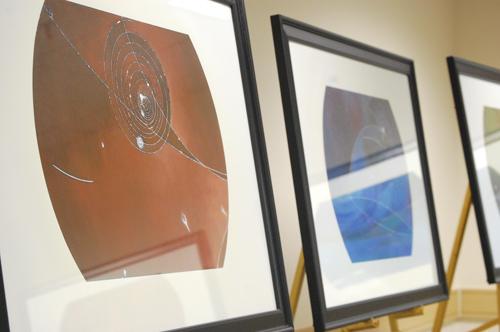
This post was written by Hatchet Reporter Eliana Reyes.
The relationship between science and art is a strange, intriguing dynamic. At times thought to be on opposite sides of the spectrum, the two subjects often intermingle, like in the natural aesthetics of a scientifically created spiral. Australian artist Lylie Fisher explores such connections through her work, which she presented in a lecture Wednesday at the Marvin Center.
GW’s physics and fine arts departments collaborated to bring Fisher to campus to speak about her latest project, entitled “In Search of Meaning.” Unlike most artist lectures, this one began with nuclear physicist and GW professor Allena Opper explaining the main inspiration for the 11 images in the series: the bubble chamber.
Used primarily in the 1960s, the bubble chamber allows scientists to learn about minuscule particles by following their tracks. Charged particles are placed in a liquid chamber through which a magnetic field is run. The magnetic field causes the particles to create tracks in different directions as opposed to just a straight line, the result of no field. Scientists can determine the charge of a particle and how much energy it has by tracing the direction, spirals and circles of its tracks. In order to record these results, a camera is placed above the chamber.
The bubble chamber experiments led to the photographs that are the basis of Fisher’s series. Enlarged and cropped versions of the photographs literally make up the foundation of her pieces; Fisher painted directly onto the images, while leaving the original lines of the particle tracks visible and untouched. What comes out is art in the form of elegant curves and spirals against a background of vivid, bold colors. Photos of science become geometric, abstract representations of what look like minute universes.
When asked why she made the decision to paint on top of the image instead of using it as a reference, Fisher said that she wished to preserve the integrity of the science and its place in history. She also felt that through painting on top of the image, she was retaining her relationship with her first love, photography.
Fisher said she was inspired to do the series while watching a television program about string theory. Having grown up in Australia with a natural interest in science, she was immediately drawn towards these experiments because of how hands-on they were. Fisher used her time during her residency at Stanford University to research these experiments, and was even able to speak to the original scientists who had worked on the bubble chamber experiments. Fisher said she was “struck by how passionate these scientists were about their work,” and saw her own relationship to art as analogous to that of the physicists with their bubble chamber.
The other noticeable thing about Fisher’s work is her use of color. She said that the color choices are unrelated to the science; it is her own contribution to the pieces, which she feels are collaborations between her and the work of the researchers. The colors, she said, are meant to add a human voice.
“’In Search of Meaning’ let me combine all of my interests in science, in art,” said Fisher, who wants to continue working with science in her . Currently, she is working on a project with GW about DNA called “Delve.” Although it is in the research and planning stages, “Delve” will involve Fisher tracing the tracks within herself by testing her own DNA and exploring her ancestry.


